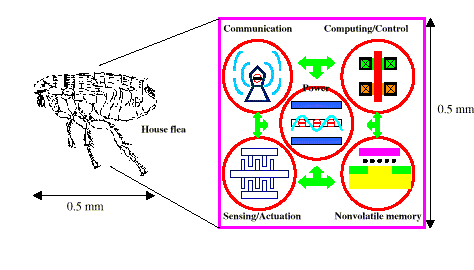Submillimeter Autonomous Microsystems Enhanced by
Mobile Nonvolatile Static Charges in Nanocrystals
School of Electrical and Computer Engineering,
Cornell University,
Ithaca, NY 14853 USA
An autonomous microsystem need to contain several basic functional modules to interact with its environment. Some insects, such as fleas, represent a natural counterpart in comparative scales. The autonomous microsystem needs to be able to sense the perturbation in environment (hearing or sight in insects), as well as to actuate perturbation to the environment for response (motion). It also needs to communicate with other microsystems to establish collective and coordinated functions (social behavior). Many of the operations involve computing and control for complex information processing. Finally, all previous functions require perturbation to the equilibrium or symmetric aspects of the environment, and are hence governed by thermodynamics, which requires the autonomous microsystem to contain a power generation/conversion unit (digestion).
Considering the scale constraints and available technology, these functions of the autonomous microsystems can be potentially realized in the integrated EEPROM/MEMS (electrically erasable programmable read-only memory/microelectromechanical systems) technology in a power-efficient manner. For example, motion sensing can be performed from electrostatic measurement of a static-charged cantilever distortion. Electrical power can be converted from a vibrating membrane with static nonvolatile charges. Strong mechanical actuation can be achieved through an electrostatic discharge event. Near-field RF signals radiated from moving static charges can be employed as communication channels. In addition to the challenges of process integration on silicon substrate, these functional units are very limited in their efficiency and may have a small design window for practical applications. This approach of system-on-a-chip (SoC) based on Si nanotechnology provides a "COMS aspect" for the biomimetic design principles. Although insects are magnificent autonomous microsystems, their creation is limited to room temperature and a large portion of the system is dedicated to reproduction. These constraints apparently do not apply to the SoC approach. As an example on communication, insects utilize chemicals effectively, while RF signals may be preferable for present EEPROM/MEMS technology.
Hardware prototypes of EEPROM/MEMS integration through hybrid foundry CMOS process will be used to demonstrate the operational principles of on-chip power generation, friction-free bearing, wireless communication and adaptive harmonic control. The basic cell contains a conventional EEPROM device pumping nonvolatile static charges to an extended floating gate. If the floating gate is one piece of electrically connected semiconductor or metal, then charge redistribution and image charges may cause performance degradation. A nanocrystal floating gate implementation will resolve this problem and have better retention time due to the Coulomb blockade effect. However, the nonvolatile charge in nanocrystals needs to be injected before operation with the Si substrate recess-etched to provide larger traveling distance. Process and device characteristics from these prototype devices will be used to estimate the system constraints of submillimeter autonomous microsystems by the SoC approach.

*Corresponding Address:
Edwin C. Kan,
404 Phillips Hall, Cornell University,
Ithaca, NY 14853,
phone: (607) 255-3998,
email: [email protected]
Web: http://www.ee.cornell.edu/~kan/
|